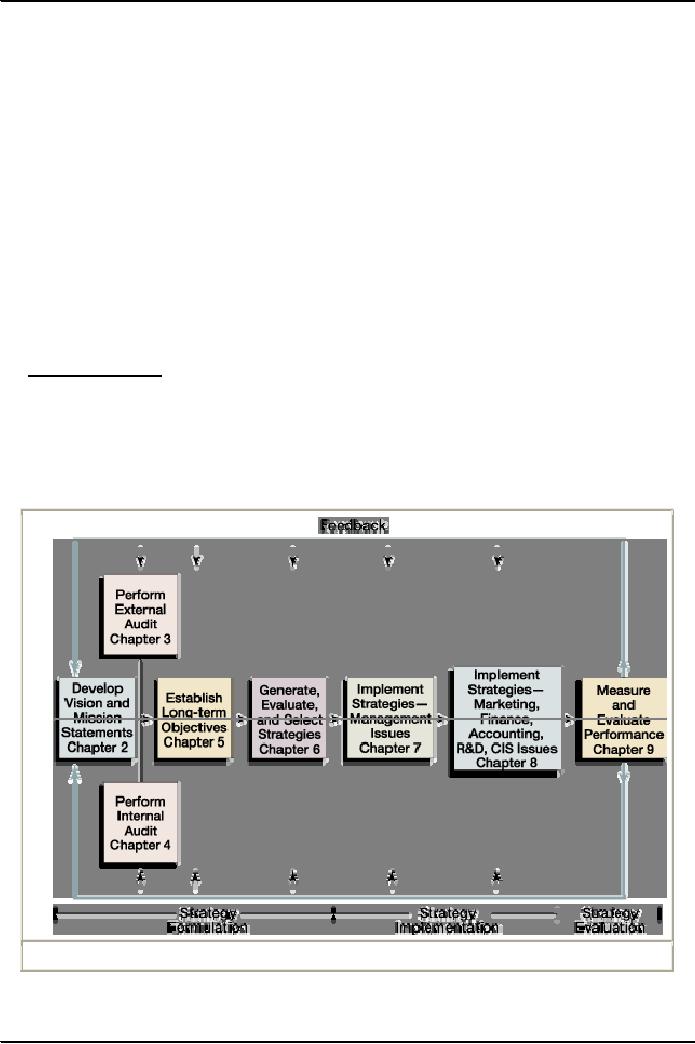 |

Strategic
Management MGT603
VU
Lesson
18
TYPES
OF STRATEGIES
Objectives:
This
lecture brings strategic
management to life with many
contemporary examples. Sixteen types
of
strategies
are defined and exemplified,
including Michael Porter's
generic strategies: cost
leadership,
differentiation,
and focus. Guidelines are
presented for determining when
different types of
strategies
are
most appropriate to pursue. An overview
of strategic management in nonprofit
organizations,
governmental
agencies, and small firms is
provided. After reading this
lecture you will be able to
know
about:
Long
term objectives:
Types
of Strategies
Integration
strategies
Strategies
in Action:
Even
if you're on the right track,
you'll get run over if you just
sit there.
--
Will Rogers
Hundreds
of companies today embrace strategic
planning because:
∑
Quest
for higher revenues
∑
Quest
for higher profits
Many
firms have to use strategic
planning in order to earn
revenues and more
profits.
Long
term objectives
Long-term
objectives represent
the results expected from pursuing
certain strategies.
Strategies
represent
the actions to be taken to accomplish
long-term objectives. The time
frame for objectives
and
strategies
should be consistent, usually from
two to five years.
The
Nature of Long-Term
Objectives
Objectives
should be quantitative, measurable,
realistic, understandable, challenging,
hierarchical,
obtainable,
and congruent among organizational units.
Each objective should also be associated
with a
time
line. Objectives are commonly
stated in terms such as
growth in assets, growth in
sales,
profitability,
market share, degree and
nature of diversification, degree
and nature of vertical
integration,
earnings
per share, and social
responsibility. Clearly established
objectives offer many
benefits. They
provide
direction, allow synergy,
aid in evaluation, establish priorities,
reduce uncertainty, minimize
conflicts,
stimulate exertion, and aid
in both the allocation of resources and
the design of jobs.
Long-term
objectives are needed at the corporate,
divisional, and functional
levels in an organization.
They
are an important measure of
managerial performance.
Clearly
stated and communicated
objectives are vital to
success for many reasons.
First, objectives help
stakeholders
understand their role in an
organization's future. They also
provide a basis for
consistent
decision
making by managers whose values
and attitudes differ. By
reaching a consensus on
objectives
during
strategy-formulation activities, an organization can
minimize potential conflicts later
during
implementation.
Objectives set forth organizational
priorities and stimulate
exertion and
accomplishment.
They serve as standards by which
individuals, groups, departments,
divisions, and
entire
organizations can be evaluated.
Objectives provide the basis
for designing jobs and
organizing
activities
to be performed in an organization. They
also provide direction and
allow for organizational
synergy.
Without
long-term objectives, an organization
would drift aimlessly toward
some unknown end! It
is
hard
to imagine an organization or individual being
successful without clear
objectives. Success
only
rarely
occurs by accident; rather, it is the
result of hard work directed
toward achieving
certain
objectives.
Not
Managing by Objectives
Strategists
should avoid:
Managing
by Extrapolation
Managing
by Crisis
78

Strategic
Management MGT603
VU
Managing
by Subjective
Managing
by Hope
Strategists
should avoid the following alternative
ways to "not managing by
objectives."
∑
Managing
by Extrapolation--adheres to the principle "If it
ain't broke, don't fix
it." The idea is to
keep
on doing about the same things in the
same ways because things are
going well.
∑
Managing
by Crisis--based on the belief that the true
measure of a really good
strategist is the
ability
to solve problems. Because
there are plenty of crises
and problems to go around for
every
person
and every organization, strategists
ought to bring their time
and creative energy to bear
on
solving
the most pressing problems of the
day. Managing by crisis is actually a
form of reacting
rather
than acting and of letting
events dictate what's and
when's of management
decisions.
∑
Managing
by Subjective--built on the idea that
there is no general plan for
which way to go and
what
to do; just do the best you
can to accomplish what you
think should be done. In short,
"Do
your
own thing, the best way
you know how" (sometimes
referred to as the
mystery approach to decision
making
because
subordinates are left to
figure out what is happening and
why).
∑
Managing
by Hope--based on the fact that the
future is laden with great
uncertainty, and that if we
try
and do not succeed, then we
hope our second (or third)
attempt will succeed. Decisions
are
predicted
on the hope that they will work
and the good times are
just around the corner, especially
if
luck and good fortune
are on our side!
Types
of Strategies
Defined
and exemplified in Table, alternative
strategies that an enterprise could
pursue can be
categorized
into thirteen actions--forward
integration, backward integration,
horizontal integration,
market
penetration, market development, product development,
concentric diversification,
conglomerate
diversification, horizontal
diversification, joint venture,
retrenchment, divestiture, and
liquidation--and
a combination strategy. Each alternative
strategy has countless variations.
For
example,
market penetration can include adding
salespersons, increasing advertising
expenditures,
coopering,
and using similar actions to
increase market share in a given
geographic area.
A
Comprehensive Strategic-Management
Model
79

Strategic
Management MGT603
VU
Alternative
Strategies Defined and
Exemplified
Strategy
Definition
Example
Forward
Gaining
ownership or
General
Motors is acquiring 10
Integration
increased
control over
percent
of its dealers.
distributors
or retailers
Backward
Seeking
ownership or
Motel-8
acquired a furniture
Integration
increased
control of a
manufacturer.
firm's
suppliers
Horizontal
Seeking
ownership or
Hilton
recently
acquired
Integration
increased
control over
Promos.
competitors
Market
Seeking
increased market
Ameritrade,
the online broker,
Penetration
share
for present products
tripled
its annual advertising
or
services in present
expenditures
to $200 million to
markets
through greater
convince
people they can make
their
own investment decisions.
marketing
efforts
Market
Introducing
present
Britain's
leading supplier of
Development
products
or services into
buses,
Henlys PLC, acquires
new
geographic area
Blue
Bird
Corp.,
North
America's
leading school bus
maker.
Product
Seeking
increased sales by
Apple
developed the G4 chip
Development
improving
present
that
runs at 500
megahertz.
products
or services or
developing
new ones
Concentric
Adding
new, but related,
National
Westminister Bank
Diversification
products
or services
PLC
in Britain buys the
leading
British
insurance company,
Legal
& General Group PLC.
Conglomerate
Adding
new, unrelated
H&R
Block, the top
tax
Diversification
products
or services
preparation
agency, said it will
buy
discount stock brokerage
Olde
Financial for $850
million
in
cash.
Horizontal
Adding
new, unrelated
The
New York Yankees
baseball
Diversification
products
or services for
team
is merging with the
New
present
customers
Jersey
Nets basketball team.
Joint
Venture
Two
or more sponsoring
Lucent
Technologies and Philips
firms
forming a separate
Electronics
NV formed Philips
organization
for
Consumer
Communications to
cooperative
purposes
make
and sell telephones.
Retrenchment
Regrouping
through cost
Singer,
the sewing
machine
and
asset reduction to
maker,
declared bankruptcy.
reverse
declining sales and
profit
80

Strategic
Management MGT603
VU
Divestiture
Selling
a division or part
Harcourt
General, the large U.S.
of
an organization
publisher,
selling its Neiman
Marcus
division.
Liquidation
Selling
all of a company's
Ribol
sold all its assets
and
assets,
in parts, for their
ceases
business.
tangible
worth
Integration
Strategies:
Integration
Strategies
Forward
Integration
Vertical
Integration
Backward
Integration
Strategies
Horizontal
Integration
Forward
integration, backward integration,
and horizontal integration
are sometimes collectively
referred
to as vertical
integration strategies.
Vertical integration strategies
allow a firm to gain control
over
distributors,
suppliers, and/or competitors. Forward
integration strategy refers to the
transactions
between
the customers and firm. Similarly, the
function for the particular supply which
the firm is being
intended
to involve itself will be
called backward integration.
When the firm looks that
other firm
which
may be taken over within the
area of its own activity is
called horizontal
integration.
Benefits
of vertical integration
strategy:
Allow
a firm to gain control
over:
Distributors
(forward integration)
Suppliers
(backward integration)
Competitors
(horizontal integration)
Forward
integration: Gaining
ownership or increased control over
distributors or retailers
Forward
integration involves gaining
ownership or increased control over
distributors or retailers.
You
can gain ownership or control
over the distributors, suppliers
and
Competitors
using forward
integration.
Guidelines
for the use of integration
strategies:
Six
guidelines when forward
integration may be an especially
effective strategy are:
81

Strategic
Management MGT603
VU
Present
distributors are expensive, unreliable,
or incapable of meeting firm's
needs
Availability
of quality distributors is
limited
When
firm competes in an industry
that is expected to grow
markedly
Organization
has both capital and
human resources needed to
manage new business of
distribution
Advantages
of stable production are
high
Present
distributors have high
profit margins
When
your present distributors
are expensive and you
think that without affecting the
quality of the
goods
you have to carry own the
operations, forward integration is
advisable.
Similarly,
if distributors are unreliable, they can
not deliver with a sustained
degree of timeliness or they
are
not in a proper way to meet
the needs of the firm, forward
integration is advisable.
Availability
of quality distributors is limited or it
is difficult to get the quality of
goods, then this need
for
a quality distributor, forward
integration is best alternative.
Suppose
you have two industries,
computers and mobile telephone
which are progressing
tremendously,
it is advisable to think of forward
integration due to the changing
environment of the
business.
Organization
has both capital and
human resources needed to
manage new business of
distribution. A
firm
has all the basic elements
to run the business safely in
that case forward
integration is best
alternate.
For
stable production, stable supply is
necessary. If you think that
present distributors are
charging high
mark
up, you may do that
operation your self in order
to avoid the mark up charges. It is
advisable that
firm
itself involve in the operations. By
gaining control, stability will be
more and profitability will
be
enhanced.
∑
When
an organization's present distributors
are especially expensive, or unreliable,
or incapable of
meeting
the firm's distribution needs
∑
When
the availability of quality distributors
is so limited as to offer a competitive
advantage to
those
firms that integrate forward
∑
When
an organization competes in an industry
that is growing and is
expected to continue to grow
markedly;
this is a factor because forward
integration reduces an organization's
ability to diversify if
its
basic industry falters
∑
When
an organization has both the capital
and human resources needed
to manage the new
business
of distributing its own
products
∑
When
the advantages of stable production
are particularly high; this is a consideration
because an
organization
can increase the predictability of the
demand for its output
through forward
integration
∑
When
present distributors or retailers
have high profit margins;
this situation suggests that a
company
profitably could distribute its
own products and price them
more competitively by
integrating
forward
Backward
Integration
Seeking
ownership or increased control of a
firm's suppliers
Both
manufacturers and retailers
purchase needed materials
from suppliers. Backward
integration is
a
strategy
of seeking ownership or increased control
of a firm's suppliers. This strategy can
be especially
appropriate
when a firm's current suppliers are unreliable,
too costly, or cannot meet the firm's
needs.
Guidelines
for Backward
Integration:
Six
guidelines when backward
integration may be an especially
effective strategy are:
When
present suppliers are
expensive, unreliable, or incapable of
meeting needs
Number
of suppliers is small and number of
competitors large
High
growth in industry
sector
Firm
has both capital and
human resources to manage
new business
Advantages
of stable prices are
important
Present
supplies have high profit
margins
∑
When
an organization's present suppliers
are especially expensive, or unreliable,
or incapable of
meeting
the firm's needs for parts,
components, assemblies, or raw
materials
82

Strategic
Management MGT603
VU
∑
When
the number of suppliers is small and the
number of competitors is large
∑
When
an organization competes in an industry that is
growing rapidly; this is a factor
because
integrative-type
strategies (forward, backward,
and horizontal) reduce an
organization's ability to
diversify
in a declining industry
∑
When
an organization has both capital
and human resources to
manage the new business of
supplying
its own raw
materials
∑
When
the advantages of stable prices
are particularly important; this is a
factor because an
organization
can stabilize the cost of
its raw materials and the
associated price of its
product
through
backward integration
∑
When
present supplies have high
profit margins, which
suggests that the business of
supplying
products
or services in the given industry is a worthwhile
venture
∑
When
an organization needs to acquire a needed
resource quickly
83

Strategic
Management MGT603
VU
Lesson
19
TYPES
OF STRATEGIES
Objectives:
This
lecture brings strategic
management to life with many
contemporary examples. Sixteen types
of
strategies
are defined and exemplified,
including Michael Porter's
generic strategies: cost
leadership,
differentiation,
and focus. Guidelines are
presented for determining when
different types of
strategies
are
most appropriate to pursue. An overview
of strategic management in nonprofit
organizations,
governmental
agencies, and small firms is
provided. After reading this
lecture you will be able to
know
about:
Types
of Strategies
Integration
strategies
Horizontal
Integration:
Seeking
ownership or increased control over
competitors
Horizontal
integration refers
to a strategy of seeking ownership of or
increased control over a
firm's
competitors.
One of the most significant trends in
strategic management today is the
increased use of
horizontal
integration as a growth strategy.
Mergers, acquisitions, and
takeovers among competitors
allow
for increased economies of
scale and enhanced transfer
of resources and
competencies.
Increased
control over competitors means
that you have to look
for new opportunities either by
the
purchase
of the new firm or hostile take
over the other firm. One organization
gains control of
other
which
functioning within the same
industry.
It
should be done that every firm
wants to increase its area
of influence, market share and
business.
Guidelines
for Horizontal
Integration:
Four
guidelines when horizontal integration
may be an especially effective strategy
are:
Firm
can gain monopolistic
characteristics without being challenged
by federal government
Competes
in growing industry
Increased
economies of scale provide major
competitive advantages
Faltering
due to lack of managerial
expertise or need for particular
resources
When
an organization can gain monopolistic
characteristics in a particular area or region
without being
challenged
by the federal government for "tending
substantially" to reduce
competition
When
an organization competes in a growing
industry
When
increased economies of scale
provide major competitive
advantages
When
an organization has both the capital
and human talent needed to
successfully manage an
expanded
organization
When
competitors are faltering due to a
lack of managerial expertise or a
need for particular
resources
that
an organization possesses; note that
horizontal integration would
not be appropriate if competitors
are
doing poorly because overall
industry sales are
declining
84
Table of Contents:
- NATURE OF STRATEGIC MANAGEMENT:Interpretation, Strategy evaluation
- KEY TERMS IN STRATEGIC MANAGEMENT:Adapting to change, Mission Statements
- INTERNAL FACTORS & LONG TERM GOALS:Strategies, Annual Objectives
- BENEFITS OF STRATEGIC MANAGEMENT:Non- financial Benefits, Nature of global competition
- COMPREHENSIVE STRATEGIC MODEL:Mission statement, Narrow Mission:
- CHARACTERISTICS OF A MISSION STATEMENT:A Declaration of Attitude
- EXTERNAL ASSESSMENT:The Nature of an External Audit, Economic Forces
- KEY EXTERNAL FACTORS:Economic Forces, Trends for the 2000ís USA
- EXTERNAL ASSESSMENT (KEY EXTERNAL FACTORS):Political, Governmental, and Legal Forces
- TECHNOLOGICAL FORCES:Technology-based issues
- INDUSTRY ANALYSIS:Global challenge, The Competitive Profile Matrix (CPM)
- IFE MATRIX:The Internal Factor Evaluation (IFE) Matrix, Internal Audit
- FUNCTIONS OF MANAGEMENT:Planning, Organizing, Motivating, Staffing
- FUNCTIONS OF MANAGEMENT:Customer Analysis, Product and Service Planning, Pricing
- INTERNAL ASSESSMENT (FINANCE/ACCOUNTING):Basic Types of Financial Ratios
- ANALYTICAL TOOLS:Research and Development, The functional support role
- THE INTERNAL FACTOR EVALUATION (IFE) MATRIX:Explanation
- TYPES OF STRATEGIES:The Nature of Long-Term Objectives, Integration Strategies
- TYPES OF STRATEGIES:Horizontal Integration, Michael Porterís Generic Strategies
- TYPES OF STRATEGIES:Intensive Strategies, Market Development, Product Development
- TYPES OF STRATEGIES:Diversification Strategies, Conglomerate Diversification
- TYPES OF STRATEGIES:Guidelines for Divestiture, Guidelines for Liquidation
- STRATEGY-FORMULATION FRAMEWORK:A Comprehensive Strategy-Formulation Framework
- THREATS-OPPORTUNITIES-WEAKNESSES-STRENGTHS (TOWS) MATRIX:WT Strategies
- THE STRATEGIC POSITION AND ACTION EVALUATION (SPACE) MATRIX
- THE STRATEGIC POSITION AND ACTION EVALUATION (SPACE) MATRIX
- BOSTON CONSULTING GROUP (BCG) MATRIX:Cash cows, Question marks
- BOSTON CONSULTING GROUP (BCG) MATRIX:Steps for the development of IE matrix
- GRAND STRATEGY MATRIX:RAPID MARKET GROWTH, SLOW MARKET GROWTH
- GRAND STRATEGY MATRIX:Preparation of matrix, Key External Factors
- THE NATURE OF STRATEGY IMPLEMENTATION:Management Perspectives, The SMART criteria
- RESOURCE ALLOCATION
- ORGANIZATIONAL STRUCTURE:Divisional Structure, The Matrix Structure
- RESTRUCTURING:Characteristics, Results, Reengineering
- PRODUCTION/OPERATIONS CONCERNS WHEN IMPLEMENTING STRATEGIES:Philosophy
- MARKET SEGMENTATION:Demographic Segmentation, Behavioralistic Segmentation
- MARKET SEGMENTATION:Product Decisions, Distribution (Place) Decisions, Product Positioning
- FINANCE/ACCOUNTING ISSUES:DEBIT, USES OF PRO FORMA STATEMENTS
- RESEARCH AND DEVELOPMENT ISSUES
- STRATEGY REVIEW, EVALUATION AND CONTROL:Evaluation, The threat of new entrants
- PORTER SUPPLY CHAIN MODEL:The activities of the Value Chain, Support activities
- STRATEGY EVALUATION:Consistency, The process of evaluating Strategies
- REVIEWING BASES OF STRATEGY:Measuring Organizational Performance
- MEASURING ORGANIZATIONAL PERFORMANCE
- CHARACTERISTICS OF AN EFFECTIVE EVALUATION SYSTEM:Contingency Planning